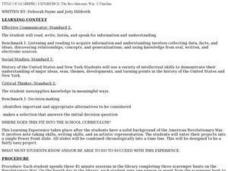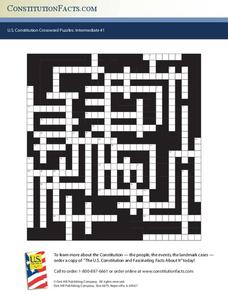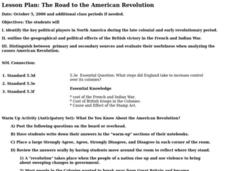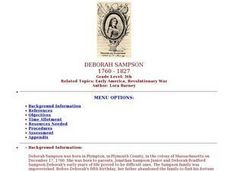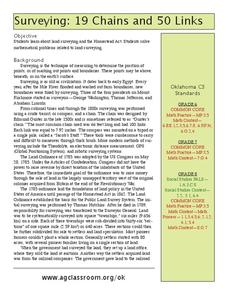National Endowment for the Humanities
Lesson 1: The United States Confronts Great Britain, 1793–1796
After the Revolutionary War, the success of the United States was far from guaranteed. Foreign powers coveted the new land, and Great Britain challenged American sovereignty. Learners consider the challenges facing the new nation using...
Reading Through History
Patriots and Loyalists
Patriots versus Loyalists, a huge divide during the Revolutionary War in what would become the United States of America. An informative resource includes both direct instruction about the two groups and a quiz pupils take after reading...
Museum of the American Revolution
Historical Analysis: Objects Tell Stories
Dig this! Young archeologists discover what objects teach us about the past. The activity uses an image of a Revolutionary War artifact to help historians practice analyzing the past. Scholars study the object and complete a worksheet to...
National Endowment for the Humanities
Lesson 2: The United States, France, and the Problem of Neutrality, 1796–1801
While the French Revolution could be considered inspired by the American Revolution, it created thorny problems for the new United States. Should the United States get involved and be drawn into a European drama? Was the US strong...
College Board
2017 AP® United States History Free-Response Questions
Were unfair taxes really the cause of the American Revolution? Learners explore the complicated historiography behind the revolutionary period using authentic College Board prompts. The free-response questions from the exam feature...
Smithsonian Institution
Lexington and Concord: Historical Interpretation
Learners view and analyze three different images related to the Battle of Lexington and Concord. They also answer a variety of questions in a graphic organizer to help keep the information straight.
Curated OER
The Revolutionary War: A Timeline
Fifth graders, in groups, spend one to two days researching their person or event. After the research process, each student has to write two to three sentences describing their person's most important contribution to the American...
Constitution Facts
U.S. Constitution Crossword Puzzles: Intermediate #1
All of the details of American history fall into place with a clever crossword puzzle. Nearly 100 clues prompt middle and high schoolers to fit the correct answers to topics including the American Revolution, the Civil War, and...
Curated OER
Johnny Tremain
Students study the Revolutionary War. For this colonial America lesson, students read Johnny Tremain by Esther Forbes. Students discuss chapter 1 as they respond to the provided discussion questions.
American Battlefield Trust
1862: Antietam and Emancipation
Was the Emancipation Proclamation a revolutionary document or just a military strategy? It proclaimed that all those enslaved in Confederate states would be "forever free." Logistically, though, it did little. The order, however,...
Constitutional Rights Foundation
How the First State Constitutions Helped Build the U.S. Constitution
Did you know that the United States Constitution was adopted after many state constitutions were already in place? Young scholars examine facts about the influence of states through an informative and interesting resource. Groups then...
Curated OER
Civil War Time Line
Students draw a time line on graph paper on a scale of one square to every five years beginning in 1770 and ending at 2000. They place historic events and inventions in their correct time period on the time line, and add their birthday...
Curated OER
Battle of Lexington and Concord
Eleventh graders study the causes of the American Revolution. In this American History instructional activity, 11th graders read a story "Guns for General Washington. Students read and discuss statements about war.
Curated OER
The Road to the American Revolution
Fifth graders explore the causes of the American Revolution. In this American Revolution lesson, 5th graders examine the people, places, and events that led to the outbreak of war in the colonies.
Curated OER
Political Cartoons
Students examine a variety of historical cartoons. They recognize a political cartoon and identify the main idea, symbolism, exaggeration and caricature in political cartoons. Students analyze a political cartoon by Benjamin Franklin.
Curated OER
Deborah Sampson
Fifth graders describe the major accomplishments of Deborah Sampson and her importance in American history. They list in chronological order the evets that took place in Deborah Sampson's life. They demonstrae their ability to...
Curated OER
19 Chains and 50 Links
Students investigate surveys as it relates to chains and links. In this math lesson plan, students relate math to history and surveys done above, below and on the earths' surface. They review vocabulary pertaining to this lesson plan...
Curated OER
Phoebe The Spy
Fourth graders read the book, Phoebe The Spy, by Judith Berry Griffin. They complete comprehension activities, make predictions about what happen next, and create a PowerPoint book report for the story.
Curated OER
Canadian Symbols
Students discover the ideals of Canada by analyzing its symbols. In this Canadian culture lesson, students identify the symbols that established the U.S. as its own nation and compare them to important Canadian symbols....
Curated OER
Surveying: 19 Chains and 50 Links
Through an interdisciplinary lesson, emerging engineers explore the history of surveying systems. After discussing various systems, they perform surveys on printable pages. Using their geometric skills, they physically stake out plots...






